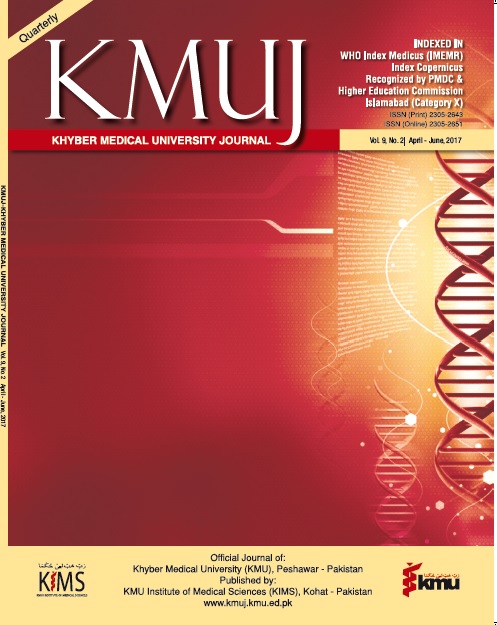PREVALENCE OF CEREBRAL PALSY IN CHILDREN OF DISTRICT SWABI, KHYBER PUKHTUNKHWA - PAKISTAN
Main Article Content
Abstract
ABSTRACT
OBJECTIVE: To study the prevalence of cerebral palsy (CP) in children of district Swabi, Khyber Pakhtunkhwa-Pakistan.
METHODS: This study was carried out among children of age 4-10 years of age at district Swabi, Khyber Pakhtunkhwa, Pakistan. The data was collected by a survey questionnaire adopted from surveillance of cerebral palsy in Europe (SCPE) study. Parents of the children were interviewed and completed the questionnaires. District Swabi comprised of 56 union councils with a population of 1.3 million (annual growth rate of 2.96%). Study was conducted at all (56) union councils between February and June 2014.
RESULTS: A total of 278 children were found as sufferers from CP, out of which 191 (68.7%) were male children and 87 (45.5%) were female. Mean age was 7.6+1.97 years. Prevalence rate was recorded as 1.22/1000 live births. The most affected children were found in the age group between 9–10 (39.6%) years. Out of 278 children, 109 (39.2%) were severely affected, 112 (40.3%) were moderately and 57 (20.5%) were mildly affected. Almost half of the children (49.6%) were suffering from spastic quadriplegia. The frequency of affected children was higher from urban areas (91.7%) as compared to rural areas (8.3%).
CONCLUSION: Prevalence of CP in children was 1.22/1000 live births in district Swabi, Khyber Pakhtunkhwa-Pakistan. Majority of affected children were in the age group of 9-10 (39.6%) years. About half of the affected children had spastic quadriplegia and severe deformities were recorded in 39.2% cases.
KEY WORDS: Cerebral Palsy (MeSH), Cerebral Palsy, Monoplegic, Infantile (MeSH), Cerebral Palsy, Quadriplegic, Infantile (MeSH), Cerebral Palsy, Spastic (MeSH), Spastic Diplegia (MeSH), Cerebral Palsy Children (Non-MeSH)
Article Details
Work published in KMUJ is licensed under a
Creative Commons Attribution 4.0 License
Authors are permitted and encouraged to post their work online (e.g., in institutional repositories or on their website) prior to and during the submission process, as it can lead to productive exchanges, as well as earlier and greater citation of published work.
(e.g., in institutional repositories or on their website) prior to and during the submission process, as it can lead to productive exchanges, as well as earlier and greater citation of published work.
References
Rosenbaum P, Paneth N, Leviton A, Goldstein M, Bax M, Damiano D, et al. A report: the definition and classification of cerebral palsy. Dev Med Child Neurol Suppl 2007;s109:8-14.
Bangash AS, Hanafi MZ, Idrees R, Zehra N. Risk factors and types of cerebral palsy. J Pak Med Assoc 2014:64(1):32–6.
Afzal E, Rabbani MW, Ahmad T, Iqbal I. Association of perinatal adverse events with the type of cerebral palsy. Pak Pediatr J 2014:38 (3):179–83.
Liu JM, Li S, Lin Q, Li Z. Prevalence of cerebral palsy in China. Int J Epidemiol 1999;28(5):949-54.
Serdaroǧlu A, Cansu A, Özkan S, Tezcan S. Prevalence of cerebral palsy in Turkish children between the ages of 2 and 16 years. Dev Med Child Neurol 2006 Jun;48(6):413-6.
Al-Sulaiman AA, Bademosi OF, Ismail HM, Al-Quliti KW, Al-Shammary SF, Abumadini MS, et al. Cerebral palsy in Saudi children. Neurosciences 2003;8(1):26-29.
Abed BK. Cerebral palsy among Iraqi children: Case-series study. Dohuk Med J 2007;(1):69-77. [Cited on January 03, 2016.] Available from URL: web.uod.ac/documents/64/DMJ_Vol1.pdf
Blackburn C, Read J, Spencer N. Children with neurodevelopmental disabilities. Chap 9. In: Lemer C, Todd K, Cheung R. (Ed). Annual Report of the Chief Medical Officer 2012, Our Children Deserve Better: Prevention Pays. [Cited on January 03, 2016.] Available from URL: http://dera.ioe.ac.uk/18694/7/33571_2901304_CMO_All_Redacted.pdf
Cans, C. Surveillance of cerebral palsy in Europe: a collaboration of cerebral palsy surveys and registers. Dev Med Child Neurol 2000;42(12):816–24.
United Nations Children’s Fund (UNICEF) Pakistan. Pakistan annual report 2013. [Cited on January 03, 2016.] Available from URL: https://www.unicef.org/pakistan/FINAL_UNICEF_Annual_Report_2013_-_Version_11.1.pdf
Yasir BN, Ashraf M. Base Line House Hold Survey Swabi District. Population Council (2010). [Cited on January 03, 2016.] Available from URL: http://www.ndma.gov.pk/Publications/Baseline%20Household%20Survey%20Ghotki.pdf.
Lang TC, Fuentes-Afflick E, Gilbert WM, Newman TB, Xing G, Wu YW. Cerebral palsy among Asian ethnic subgroups. Pediatrics 2012 Apr 1;129(4):e992-8.
Singhi PD, Ray M, Suri G. Clinical spectrum of cerebral palsy in North India—an analysis of 1000 cases. J Trop Pediatr 2002 Jun 1;48(3):162-6.
